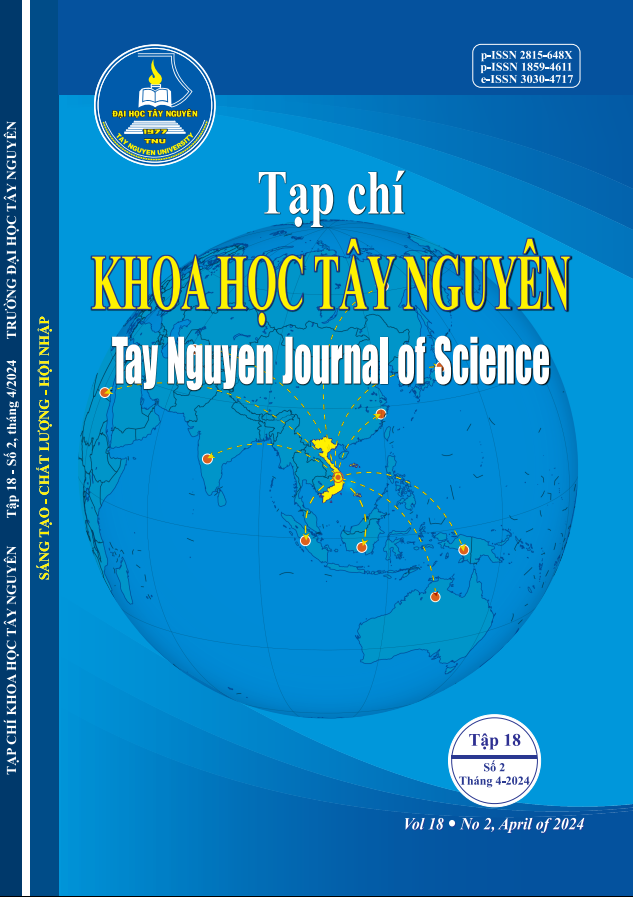Nghiên cứu tạo nguồn vật liệu khởi đầu trong nuôi cấy mô cây tre Tứ Quý
Main Article Content
Nghiên cứu tạo nguồn vật liệu khởi đầu trong nuôi cấy mô cây tre Tứ Quý
Tóm tắt
Cây tre Tứ Quý là loài tre lấy măng có nguồn gốc từ Đài Loan và có giá trị kinh tế cao. Nghiên cứu tạo nguồn vật liệu khởi đầu trong nhân giống in vitro cây tre Tứ quý là cần thiết trong việc nhân giống và phát triển loài tre này tại tỉnh Đăk Lăk. Trong nghiên cứu này, dung dịch NaOCl được sử dụng để khử trùng các mẫu đốt thân và măng tre với các nồng độ, thời gian xử lý khác nhau nhằm tạo nguồn mẫu in vitro. Kết quả cho thấy, khử trùng bằng NaOCl nồng độ 20% trong 30 phút cho hiệu quả tốt nhất đối với mẫu măng tre, với tỷ lệ mẫu sống không nhiễm đạt 72,59%, trong khi sử dụng NaOCl 40% trong 20 phút cho hiệu quả với các đốt thân, với tỷ lệ mẫu sống không nhiễm là 63,15%. Bên cạnh đó, nghiên cứu sự phát sinh hình thái ở mẫu măng tre trên môi trường Murashige và Skoog, 1962 (MS) bổ sung 1 mg/L BA và các nồng độ NAA khác nhau cho thấy, sự hình thành chồi xảy ra trên môi trường chỉ chứa BA và sự cảm ứng tạo mô sẹo tốt nhất trên môi trường chứa 5 mg/L NAA. Kết quả nghiên cứu là nguồn vật liệu khởi đầu trong việc xây dựng quy trình nhân giống cây tre Tứ quý bằng phương pháp nuôi cấy mô.
Article Details

Tác phẩm này được cấp phép theo Giấy phép quốc tế Creative Commons Attribution-NonCommercial-NoDeri Phái sinh 4.0 .
Tài liệu tham khảo
- Lê Văn Hòa, Nguyễn Văn Ây & Phan Thị Ánh Nguyệt. (2012). Sự tạo phôi soma và tái sinh chồi tre rồng (Dendrocalamus giganteus Wall. Ex Munro) từ nuôi cấy lớp mỏng tế bào. Tạp chí Khoa học (Trường Đại học Cần Thơ), 21b, 68-77.
- Brar, J. (2014). Micropropagation of some edible bamboo species and molecular characterization of the regenerated plants. Ph. D thesis. Thapar University, Patiala.
- Chang W.C. and Ho C.W. (1997). Micropropagation of Bamboos. In Biotechnology in Agriculture and Forestry. High-tech and Micropropagation V (pp 203-219). New York: Springer Berlin, Heidelberg.
- Schaller G.E., Bishopp A., and Kieber J.J. (2015). "The yin-yang of hormones: cytokinin and auxin interactions in plant development," The Plant Cell, 27 (1), 44-63.
- Hassan A.A.E. and Debergh P. (1987). Embryogenesis and plantlet development in the bamboo Phyllostachys viridis (Young) McClure. Plant Cell Tiss Org Cult 10, 73-77.
- Huang L.C., Huang B.L., and Chen W.L. (1989). Tissue culture investigations of bamboo - IV. Organogenesis leading to adventitious shoots and plants in excised shoot apices. Environ Exp Bot, 29, 307-315.
- Huang L.C. et al. (2002). High polyphenol oxidase activity and low titratable activity in browning bamboo tissue culture. In Vitro Cell Dev Biol Plant, 38, 358-365.
- Mehta, R. et al. (2010). Induction of somatic embryogenesis and analysis of genetic fidelity of in vitro derived plantlets of Bambusa nutans Wall., using AFLP markers. Eur. J. For. Res., 130(5), 729-736.
- Mudoi K.D., Saikia S.P. and Borthakur M. (2014). Effect of nodal positions, seasonal variations, shoot clump and growth regulators on micropropagation of commercially important bamboo, Bambusa nutans Wall. ex. Munro. African Journal of Biotechnology, 13(19), 1961-1972.
- Nadgauda R.S., Parasharami V.A. and Mascarenhas A.F. (1990). Precocious flowering and seeding behaviour in tissue-cultured bamboos. Nature, 344, 335-336.
- Nadha, H.K. (2012). In vitro clonal propagation of some important woody bamboos and ascertaining their clonal fidelity. Ph.D. thesis. Thapar University, Patiala.
- Negi D. and Saxena S. (2011). Micropropagation of Bambusa balcooa Roxb. through axillary shoot proliferation. In Vitro Cell Dev Biol Plant, 47, 604-610.
- Ogita S. (2005). Callus and cell suspension culture of bamboo plant, Phyllostachys nigra. Plant Biotechnol, 22, 119-125.
- Ogita S., Kashiwagi H., Kato Y. (2008). In vitro node culture of seedlings in bamboo plant, Phyllostachys meyeri McClure. Plant Biotechnol, 25, 381-385.
- Ornellas T.S. et al. (2019). Micropropagation of Guadua chacoensis (Rojas) Londoño & P. M. Peterson. Pesq. Agropec. Trop, 49, e55450.
- Ramanayake S.M.S.D. (2006). Micropropagation of tropical bamboos. Floriculture, Ornamental and Plant Biotechnology: Advances and Topical Issues Vol 2 Global Science Books (pp 540-550). UK: Isleworth.
- Ravikumar R. et al. (1998). In vitro shoot propagation of Dendrocalamus strictus Nees. Plant Cell Tiss. Organ Cult, 52, 189-192.
- Rout G.R. and Das P. (1994). Somatic embryogenesis and in vitro flowering of 3 species of bamboo. Plant Cell Rep, 13, 683-686.
- Singh M., Jaiswal U., Jaiswal V.S. (2000). Thidiazuron - induced in vitro flowering in Dendrocalamus strictus Nees. Curr. Sci, 79, 1529-1530.
- Verma P. and Mishra N. (2018). A review in vitro regeneration of bamboo plants by plant culture techniques. Int. J. Adv. Sci. Eng. Tech, 6(4), 2321-8991.



